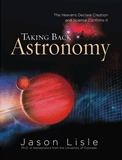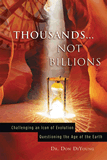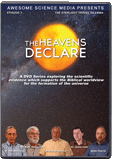Deflating Billions of Years
Is there proof that the earth and universe must be old—billions of years old? Unfortunately for those who believe in an ancient universe, these “proofs” fall apart under scrutiny—and ignore the greatest source of historical information humanity has.
The majority of evidences for vast ages depend upon starting assumptions. Be alert for such phrases as “at a measurable rate” or “continuity” or “growth patterns.” These phrases essentially mean that the given reason that the universe must be old requires that several assumptions must be true:
- the current rate is extrapolated into the past,
- the starting value is assumed,
- and little or no allowance is made for contamination into the system beyond what we measure today
This, in essence, is the key to the naturalistic philosophy. Naturalists observe the present condition of the universe and assume that what we see today is what has always been.
However, the flaw of this philosophy is that it rests upon a very tenuous foundation. If conditions have not always been the same as they are now or at the same rate, then the philosophy falls, as do the “proofs” for an old universe. You will often find that simply examining the assumptions will help you uncover the flaws.
Specific Examples
Coral Growth
Many claim that coral reefs, such as the Great Barrier Reef in Australia, are so massive that they must have taken hundreds of thousands of years to develop. However, this relies on estimations of the current growth rates of coral in present environments. If coral has grown or does grow faster than our estimations, this proof is no longer a proof. And, in fact, there is evidence that the growth rate can be much greater than uniformitarians currently assume.
See:
Continental Drift
Some geologists claim that since we can measure the current rate of continental drift, we can also measure how long the process has been occurring. However, such a claim assumes that the rate of drift is and has been the same for much of earth history and ignores the growing evidence for catastrophic (rapid) plate tectonics in the past.
See:
Distant Starlight
When we peer into the night sky, we can see the light from objects billions of light-years away. To many astronomers, this means that the universe must be billions of years old. However, there are many assumptions inherent in such a claim as well (the speed of light has always been constant, e.g.). And even if those assumptions are true, creation astronomers have developed many cosmological models that fit with our current understanding of the universe, allow for a recent creation, and, in fact, make more sense of the data. (And don’t forget that the big bang model has its own starlight problem.)
See:
Geomagnetic Reversals
Geomagnetic reversals (when the earth’s magnetic field changes polarity) are recorded in the geologic record of the earth. Currently, the method that most scientists postulate for such an event to occur would seem to indicate that the earth is millions of years old. The problem is that their model for the generation of the earth's magnetic field, the dynamo model, is not testable and fails to explain the evidence that the reversals were rapid. So, the assumption of age depends upon the prior acceptance of the secular model. Creation geologists have found, instead, that the Genesis Flood offers a better explanation for the reversals in a much shorter period of time.
See:
- Fossil Magnetism Reveals Rapid Reversals of the Earth's Magnetic Field
- The Earth’s Magnetic Field and the Age of the Earth
Ice Layers
When scientists drill down into layers and layers of ice, many claim that they can read the years into these layers based on what they believe about the past history of the earth and radioactive isotopes. Much like tree rings, the layers, they claim, show them age and even the climate and other events hundreds of thousands of years ago. However, you will often notice that evidence of rapid layer deposition in the present is quickly discounted. Once again, such age claims depend upon untestable assumptions about the past and a prior commitment to an old earth. Creation scientists, however, know that these supposed annual layers provide astounding evidence for a post-Flood Ice Age in the recent past.
See:
Petrifaction (Petrification)
You may have read from some skeptics that petrifaction (the preservation of wood) takes many millions of years to occur. However, the process of petrifaction has been shown to take only months in laboratory experiments, and the same chemical components and conditions used there are also found today in natural settings, which provide documented instances of accelerated petrifaction. It’s not just theoretical; it’s observed.
See:
Radiometric Dating
This is the most often used objection to a young earth. As radioactive elements age, they break down into daughter elements at a presently consistent rate (based on our current knowledge). However, the problems with untestable assumptions in dating methods are most obvious here, as a “date” depends on 1) knowing the starting amount, 2) knowing the history of the decay rate, and 3) knowing that all contamination has been accounted for. Obviously, these assumptions cannot be proven without an objective history of the specimen being studied. In fact, there is growing evidence that radioactive decay has not always been constant and that the rock layers could not have formed over millions of years.
See:
- Does Radiometric Dating Prove the Earth Is Old?
- Radiometric Dating: Back to Basics
- The Fallacies of Radioactive Dating of Rocks
“Varves”
Varves, put simply, are alternating bands of sedimentation said to represent a year in the geologic record (light and coarse for summer, dark and fine for winter). In the Green River Formation in the western United States, for example, uniformitarians claim that these millions of varves represent millions of years. They also claim that pollen levels and sun cycle data correlate the “varves” to an annual deposition. But do you notice the problems?
First, there is abundant evidence that varves are not varves at all, but rather rhythmites (any repeating unit of sedimentation not tied to specific time spans). For example, the regularity of the sedimentation calls into question annual deposition, as do the fossils contained within. Laboratory tests and field experiments have shown that multiple layers can be and are formed rapidly (See
See:
- Green River Formation Very Likely Did Not Form in a Postdiluvial Lake
- Are There Half a Million Years in the Sediments of Lake Van?
- Experiments on Lamination of Sediments
Equipped for the Next “Proof”
Debunking claims that “prove” the earth must be billions of years old often begins with examining the presuppositions of the writer(s). You will often find that each proof rests upon the following requirements: 1) present processes explain past processes (i.e., if it happens like this now, it must have done so—for the most part—in the past), 2) the starting state is known (i.e., how much of whatever was being measured or the first condition of the object is established), and 3) all events are accounted for (i.e., all contamination or outside influences are known).
In the case of uniformitarian dating methods, a great deal is left out. The evidence that we have (the rock record and fossils) shows that the present is not the key to understanding what happened in the past. For that, we need an objective account of history—an account that outlines the starting state of the universe and the earth and the events that transformed them. From such a starting point, we can make sense of the true age of the universe and make sense of the world around us.
Thankfully, God provided just such a history through His Word—the Bible.
Resources from Our Online Store
Recommended Resources

Answers in Genesis is an apologetics ministry, dedicated to helping Christians defend their faith and proclaim the good news of Jesus Christ.
- Customer Service 800.778.3390
- © 2024 Answers in Genesis





